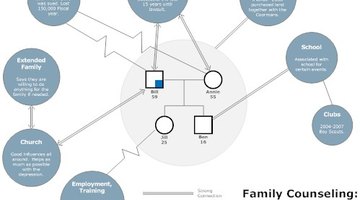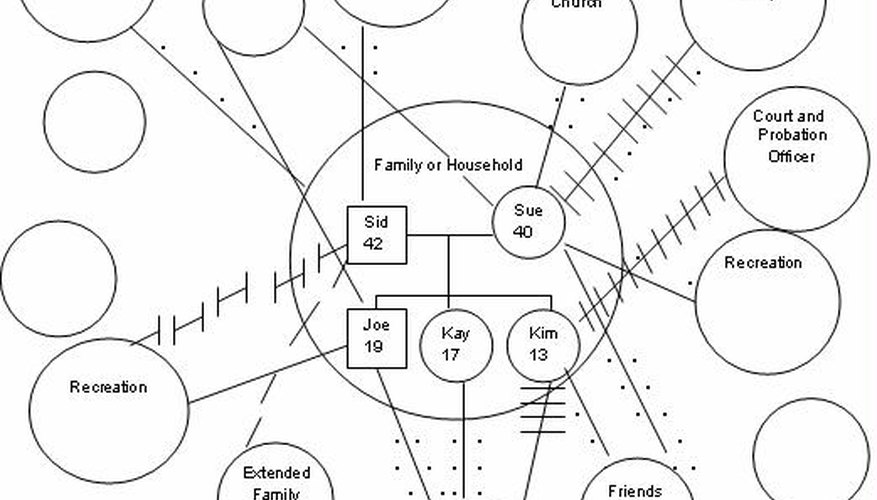Social workers apply ecomaps as a tool in family and individual counselling. With standardised symbols and lines, ecomaps depict relationships, behaviours and social networks. They identify both strong and weak connections, helping focus the efforts of social workers to mend families and advise troubled individuals. Ecomaps were devised in 1978 by Dr. Ann Hartman, a 40-year veteran of social work and a former dean of the Smith College School for Social Work. Today, ecomaps are a common therapeutic tool used in social work worldwide.
Draw a circle in the middle of the poster. Inside this circle, draw the members of one household. Use squares for males, circles for females, triangles for an unknown gender and Xs for people no longer living.
- Social workers apply ecomaps as a tool in family and individual counselling.
- Use squares for males, circles for females, triangles for an unknown gender and Xs for people no longer living.
Connect the parents in the household with lines that represent the status of their relationship: a solid line for married, a solid line with a diagonal slash for separated, and a solid line with two diagonal slashes for divorced. If one parent has custody of children, the dashes are drawn closer to the parent who does not have custody. If custody is joint, the slashes are drawn in the middle.
- Connect the parents in the household with lines that represent the status of their relationship: a solid line for married, a solid line with a diagonal slash for separated, and a solid line with two diagonal slashes for divorced.
- If one parent has custody of children, the dashes are drawn closer to the parent who does not have custody.
Draw the children beneath the parents, with vertical lines linking children to their parents. Children are depicted from left to right, with the oldest on the left. Twins are connected to each other by a solid line; another solid line is drawn from them to the parents. Abortions or miscarriages are drawn as triangles with slashes. To indicate a child has moved out, draw a short horizontal line through the vertical line.
If you have enough space, write in names, birthdays and dates of marriages, divorces, deaths or any other significant family events. Information pertaining to particular individuals can go within or adjacent to their circles; details about relationships can go next to the appropriate relationship line.

Ponder what outside systems influence the family or individual members, such as work, school, church, health care, friends and recreational activities. Draw circles for each of these outside influences.
Use lines to connect these systems to the family circle as a whole or to specific individuals. A solid line represents a strong connection; two or three solid lines represent an intense connection; a dashed or dotted line represents a tenuous connection; and a squiggly or slashed line represents a stressful or conflicted connection.
- If you have enough space, write in names, birthdays and dates of marriages, divorces, deaths or any other significant family events.
- Use lines to connect these systems to the family circle as a whole or to specific individuals.
For further knowledge, use arrows at the end of each line to represent the energy flow between the connections. Draw an arrow pointing at the family member, if the member is influenced by the outside system. Draw an arrow pointing at the outside system, if the household member is more influential. Arrows on both sides represent a mutual influence between the connections.
TIP
You can draw an ecomap yourself or use a computer programs, such as SmartDraw.com. However, you should have a licensed social worker review the material and discuss the problems and solutions with the family.
